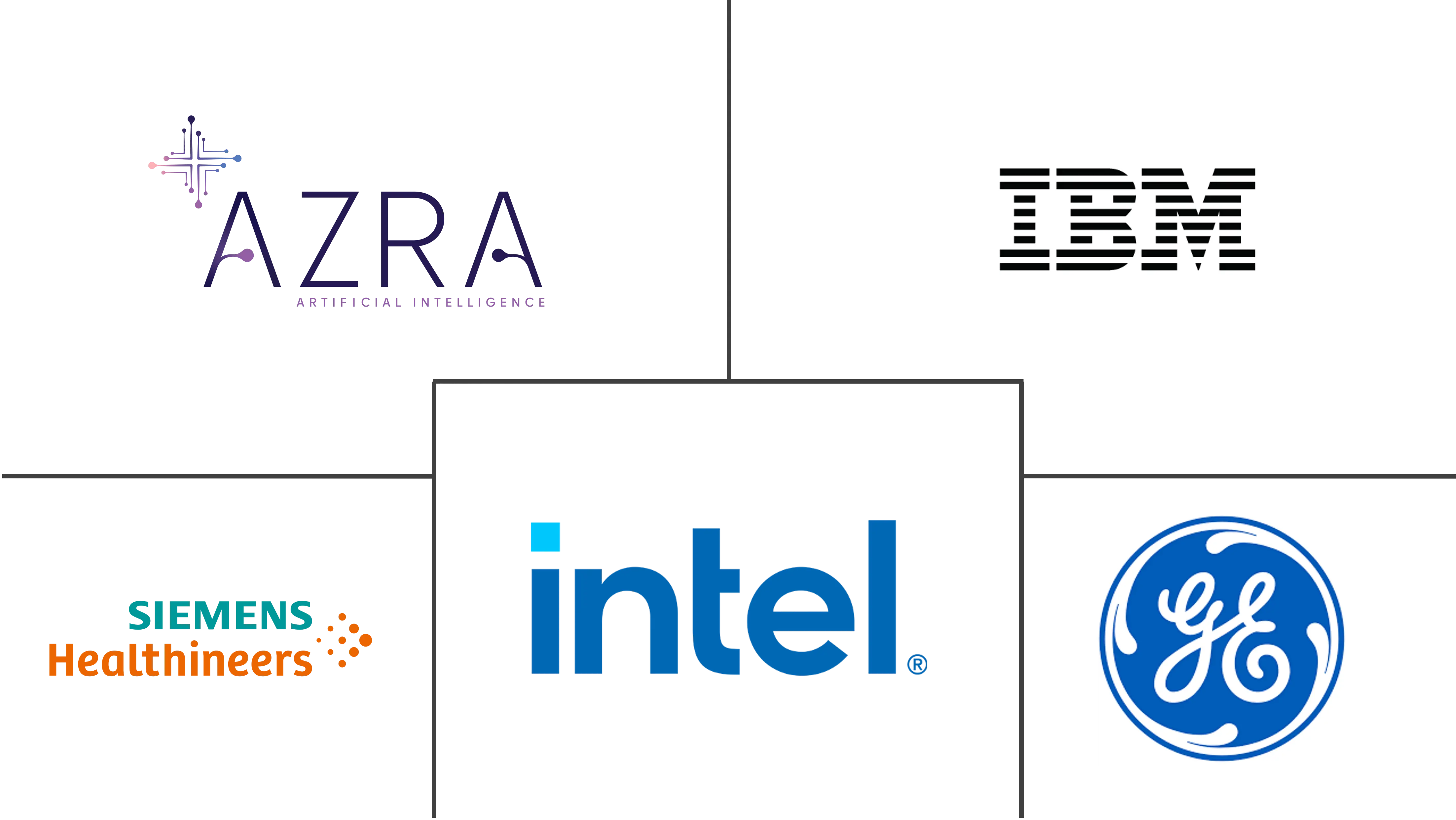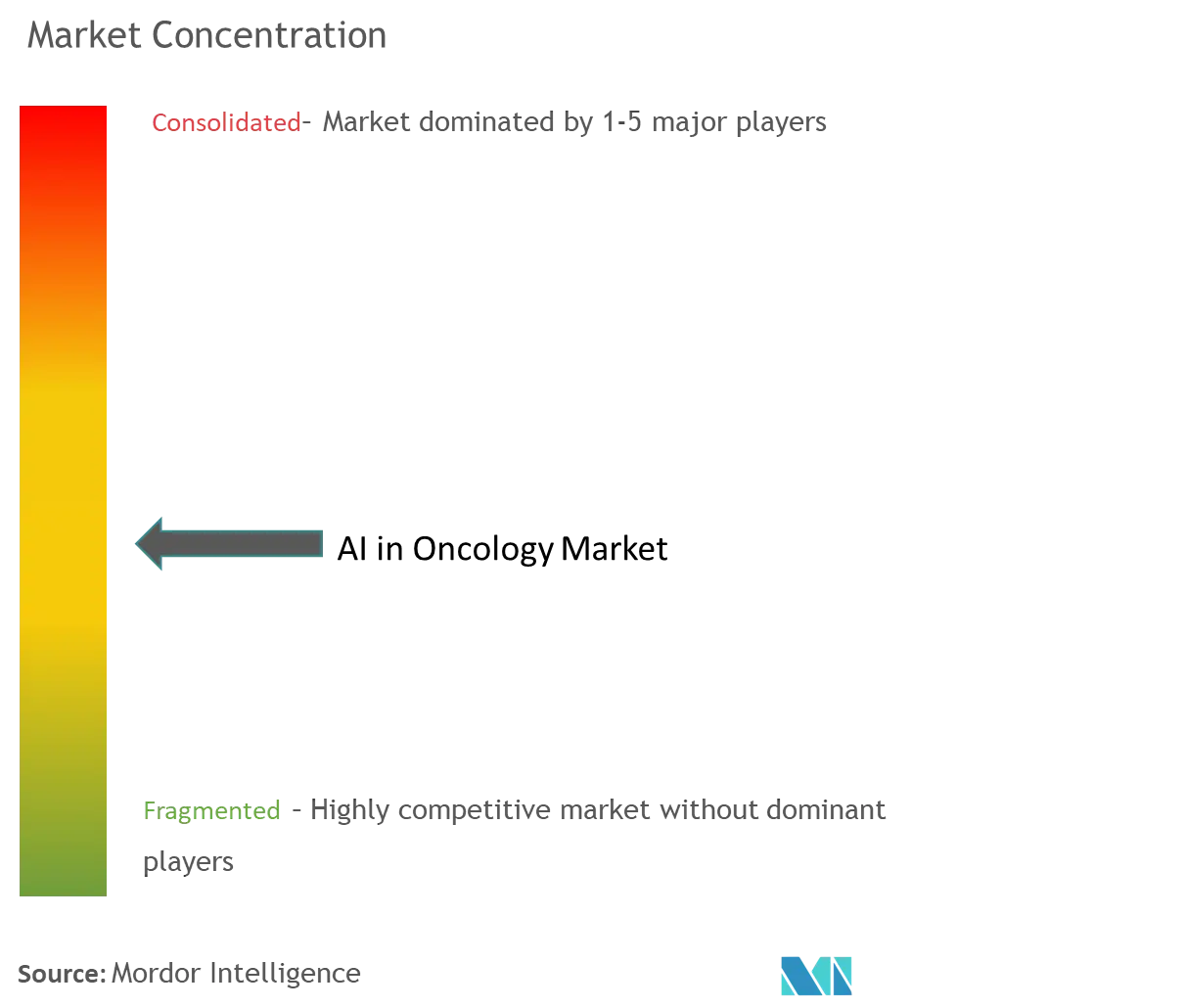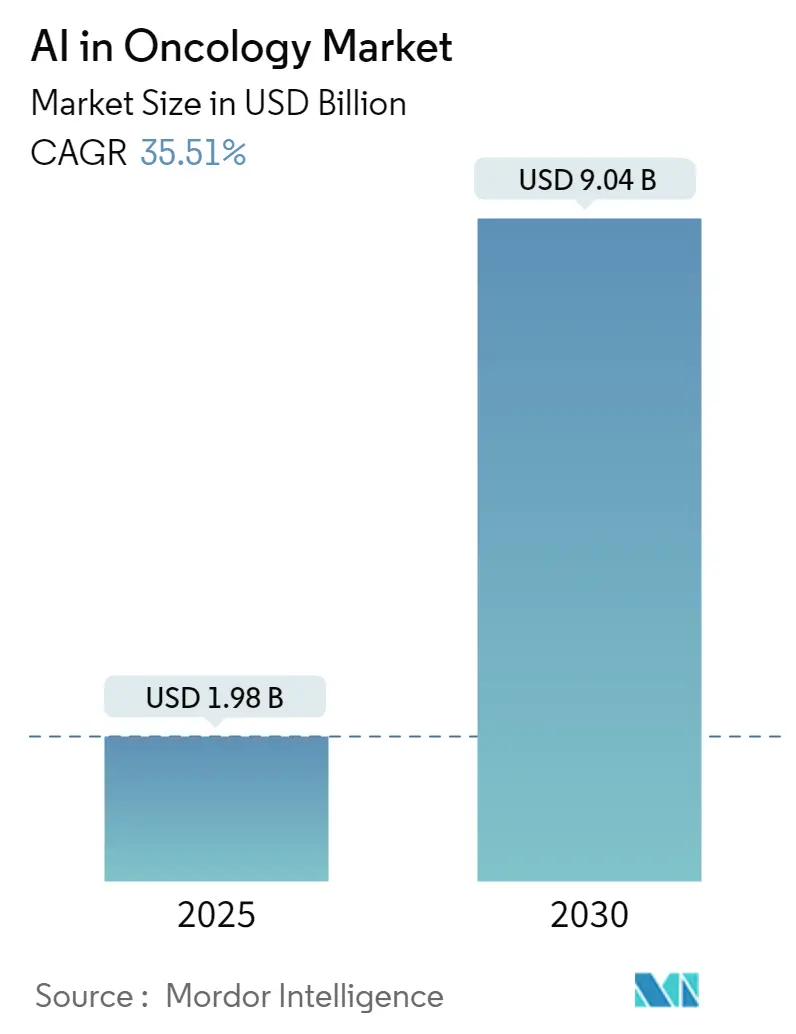
AI in Oncology Market Analysis
The AI in Oncology Market size is estimated at USD 1.98 billion in 2025, and is expected to reach USD 9.04 billion by 2030, at a CAGR of 35.51% during the forecast period (2025-2030).
One of the main aspects that supported the market growth during the pandemic was the increased adoption of AI to diagnose, treat, and analyze complicated datasets, which helped to minimize the burden on the hospital infrastructure and the physicians. According to the article published by Elsevier in December 2021, the recent advancements in AI and machine learning (ML) boosted the diagnosis and treatment of lung cancer through the utilization of cutting-edge technologies. For instance, the incorporation of clinical and imaging data with ML methods led to the differentiation between lung infections produced by immunotherapy and those produced by the COVID-19 virus.
In addition, the risk of the COVID-19 virus is higher in those already suffering from lung cancer. As per the article published in the Asian Pacific Journal of Cancer Care in November 2020, cancer patients, particularly those with lung cancer, have weaker immune systems, making them more susceptible to COVID-19 and other consequences. Also, due to lockdown restrictions, cancer patient diagnosis, treatment, and care were particularly challenging during the pandemic. Modern AI and ML offer the potential to improve cancer patient diagnosis, care, and therapy in such circumstances.
Furthermore, during the pandemic, AI was employed to manage the backlog of cancer imaging, reducing workloads on healthcare professionals. As per the article submitted by Springer Nature Limited in October 2022, AI was being used for the detection of skin cancer, lung cancer, breast cancer, and cervical cancer to assist in managing the backlog of cancer image analysis that grew as a result of the workforce shortages during the pandemic.
The key factor that is anticipated to propel market expansion over the forecast period is high cancer prevalence all over the world. For instance, as per the American Cancer Society, Inc., there will be around 1.9 million new cancer diagnoses and 609,360 deaths due to cancer in the United States by the end of 2022. Additionally, according to the WHO, in February 2022, lung, breast, rectum, and colon cancers were the most common ones. Furthermore, globally one-third of cancer deaths occur due to the increase in body mass index, high tobacco use, and lack of physical activity. Thus, the rising prevalence of cancer worldwide is likely to boost the adoption of AI for its accurate diagnosis, thereby contributing to the growth of the market studied.
In addition, the expanding healthcare infrastructure advancements worldwide are also propelling the market growth. For instance, in July 2021, the Centre for Fourth Industrial Revolution of the World Economic Forum India announced the launch of the Fourth Industrial Revolution for Sustainable Transformation (FIRST) of the Cancer Care project to focus on advanced technologies like AI, IoT, and blockchain to deliver affordable, easily accessible, and high-quality cancer care in India. Thus, the expansion of healthcare infrastructure is expected to boost market growth during the forecast period.
Furthermore, in recent years, there has been a surge in the adoption of AI in the radiographic imaging of breast cancer for its early detection and diagnosis. Federal agencies have increased the approval of various AI and machine learning (ML) based medical devices for breast cancer diagnosis, which is burgeoning the market growth. For instance, FDA has approved around 178 AI/ML-based medical devices till October 2022, such as Visage Breast Density medical device by Visage Imaging GmbH in January 2021 and Imagio Breast Imaging System by Seno Medical Instruments, Inc., in January 2021. Thus, owing to the active involvement of the FDA in the approval of numerous AI-enabled medical devices is expected to have significant growth over the forecast period.
Therefore, owing to the factors as mentioned above the market studied is anticipated to witness growth over the forecast period. However, high initial costs and concerns over the replacement of the human workforce are likely to impede market growth.
AI in Oncology Market Trends
Chemotherapy Segment is Expected to Have a Highest Growth Rate in the Forecast Period
The chemotherapy-based treatment utilizes drug molecules that destroy fast-moving cancer cells. The integration of AI in chemotherapy treatment assists healthcare professionals in the development of a personalized digital profile of the patients, through which their dose can be tailored during the treatment. The increase in research activities for incorporating AI in chemotherapy further accelerates segment growth. For instance, in June 2022, the National University of Singapore (NUS) announced the development of the CURATE.AI solution, which utilizes various clinical data, such as the dosage of the drug, medications, and presence of biomarkers, to customize the digital profile of the patient that provides personalized chemotherapy dosage recommendations resulting in the improvements in cancer patient outcomes. Hence, owing to the advantages offered by the incorporation of AI in chemotherapy, such as tailoring of chemotherapy dosages resulting in fewer side effects, prediction of cancer recurrence by using AI models, and high accuracy, the adoption of these products is likely to increase among the target population, ultimately driving the market growth.
In addition, AI models are being employed to predict chemotherapy responses and cancer prognosis, driving the segment's growth. For instance, in September 2022, a study was presented at the European Society for Medical Oncology (ESMO) Congress 2022, highlighting the likelihood of cisplatin-based neoadjuvant chemotherapy response in muscle-invasive bladder cancer (MIBC), which resulted in the reduction of treatment-related morbidity and optimization of cancer treatment outcomes. Hence, the adoption of AI models for the prediction and prognosis of cancer is driving segment growth.
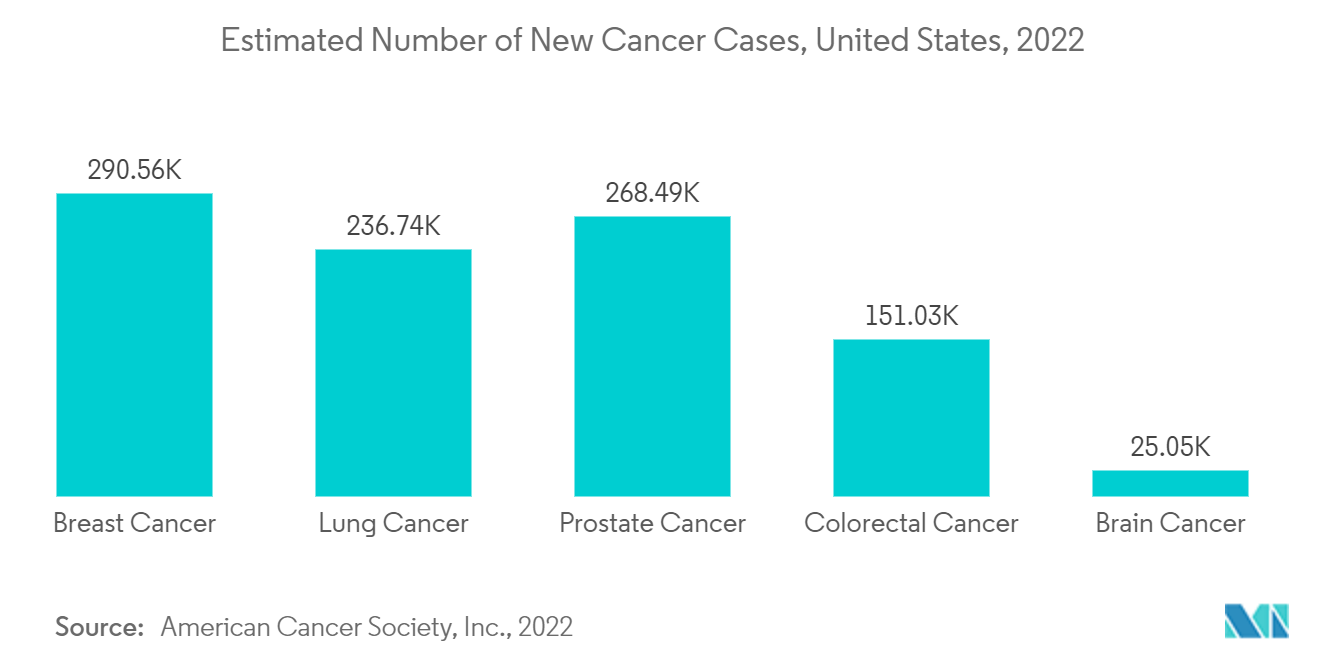
North America is Expected to Dominate the AI in Oncology Market
North America is expected to dominate the market owing to factors such as the presence of digital infrastructure and favorable governmental and reimbursement regulations. For instance, as per the article published in Elsevier in September 2022, AI reduces MRI scanning time, resulting in cost reduction and time-saving, thus, higher patient outcomes. In the United States, the government provides direct reimbursement policies to democratize healthcare access to the country to improve overall health outcomes. Thus, an increase in government reimbursements in the United States is among the key factors contributing to the growth of the market studied in North America.
The adoption of AI in oncology has reduced overall cancer treatment costs without affecting the quality of care, which is burgeoning its demand in the region. For instance, as per the study conducted by the American Society of Clinical Oncology, there were approximately 5% reductions in treatment costs for medical oncology in the United States in 2022. Thus, there is a surge in the adoption of AI in oncology in the region, which is intensifying regional growth.
Key product launches, the high concentration of market players, and strategic collaborations amongst key players in the United States are some of the factors driving AI's growth in the country's oncology market. For instance, in November 2021, Sanofi-Aventis U.S. LLC. announced a strategic investment of USD 180 million with the U.S.-based AI precision medicine company Owkin, Inc. for the advancement of its oncology pipeline. This collaboration will help Sanofi's expanding oncology portfolio in key areas like lung cancer, breast cancer, and multiple myeloma to optimize clinical trial design and detect predictive biomarkers for illnesses and treatment outcomes with the aid of AI. These continuous strategic collaborations in the region are anticipated to drive the growth of the market in the country.
Therefore, owing to the aforesaid factors, the growth of the studied market is anticipated in the North America Region.
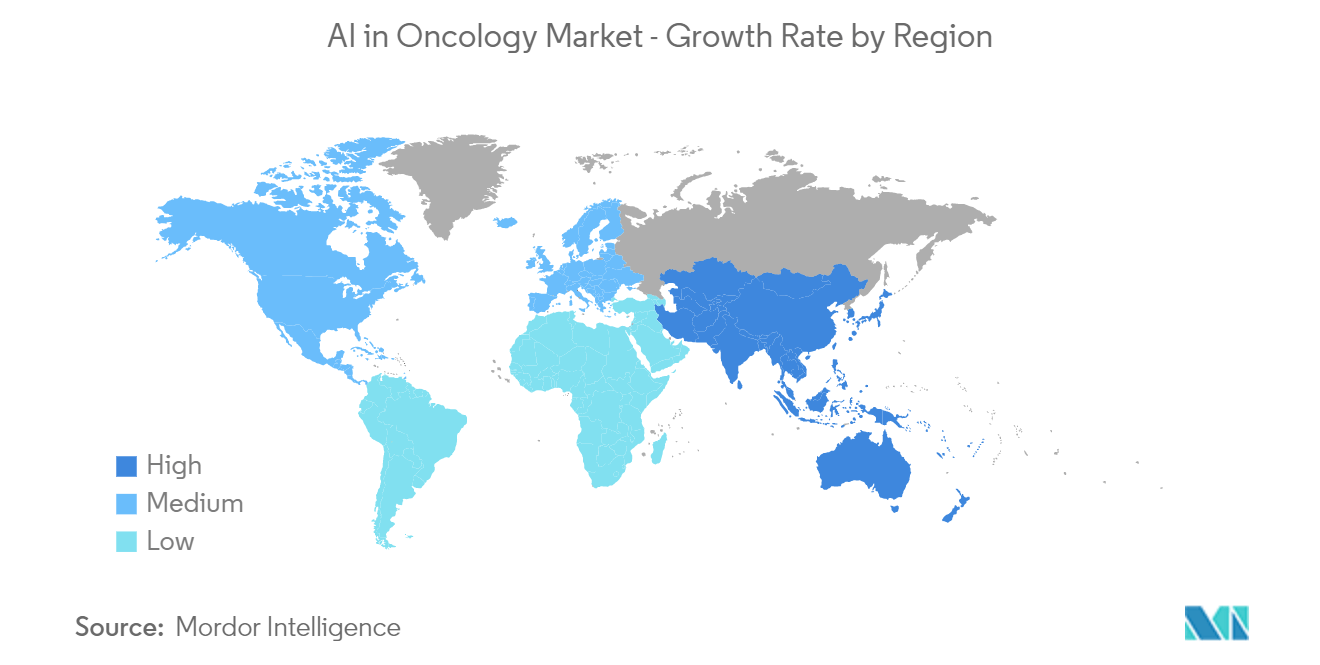
AI in Oncology Industry Overview
The AI in Oncology Market is fragmented due to the presence of several companies operating globally and regionally. The competitive landscape includes an analysis of a few international as well as local companies which hold market shares and are well known, including Azra AI, IBM Corporation, Siemens Healthineers AG, Intel Corporation, GE Healthcare, NVIDIA Corporation, Digital Diagnostics Inc., ConcertAI LLC, Median Technologies Inc, and PathAI.
AI in Oncology Market Leaders
-
Azra AI
-
IBM Corporation
-
Siemens Healthineers AG
-
Intel Corporation
-
GE Healthcare
- *Disclaimer: Major Players sorted in no particular order
AI in Oncology Market News
- In September 2021, Owkin, Inc., in collaboration with Cleveland Clinic researchers, announced the development of a deep-learning model that predicts survival and health outcomes for hepatocellular carcinoma.
- In August 2022, Medtronic plc launched a GI GeniusTM intelligent endoscopy module in India. It is powered by AI and assists healthcare practitioners in the detection of colorectal cancer through enhanced visualization during colonoscopy.
AI in Oncology Industry Segmentation
Oncology uses artificial intelligence (AI) to diagnose cancer more quickly and accurately, which improves patient outcomes and is expected to fuel market growth over the next five years. AI uses computer programs that examine enormous volumes of data to predict cancer. AI applications in oncology may enhance cancer detection, diagnosis, and therapy planning.
The AI in Oncology market is segmented by Component (Software Solutions, Hardware, and Services), Cancer Type (Breast Cancer, Lung Cancer, Prostate Cancer, Colorectal Cancer, Brain Tumor, and Other Cancer Types), Treatment Type (Chemotherapy, Radiotherapy, Immunotherapy, and Other Treatment Types), Application (Cancer Detection, Drug Discovery, Drug Development, and Other Applications), and Geography (North America (United States, Canada, and Mexico), Europe (Germany, United Kingdom, France, Italy, Spain, and Rest of Europe) Asia-Pacific (China, Japan, India, Australia, South Korea, and Rest of Asia-Pacific), Middle East and Africa (GCC, South Africa, and Rest of Middle East and Africa), and South America (Brazil, Argentina, and Rest of South America). The market report also covers the estimated market sizes and trends for 17 countries across major global regions. The report offers the value (in USD million) for the above segments.
| By Component | Software Solutions | ||
| Hardware | |||
| Services | |||
| By Cancer Type | Breast Cancer | ||
| Lung Cancer | |||
| Prostate Cancer | |||
| Colorectal Cancer | |||
| Brain Tumor | |||
| Other Cancer Types | |||
| By Treatment Type | Chemotherapy | ||
| Radiotherapy | |||
| Immunotherapy | |||
| Other Treatment Types | |||
| By Application | Cancer Detection | ||
| Drug Discovery | |||
| Drug Development | |||
| Other Applications | |||
| By Geography | North America | United States | |
| Canada | |||
| Mexico | |||
| Europe | Germany | ||
| United Kingdom | |||
| France | |||
| Italy | |||
| Spain | |||
| Rest of Europe | |||
| Asia-Pacific | China | ||
| Japan | |||
| India | |||
| Australia | |||
| South Korea | |||
| Rest of Asia-Pacific | |||
| Middle East and Africa | GCC | ||
| South Africa | |||
| Rest of Middle East and Africa | |||
| South America | Brazil | ||
| Argentina | |||
| Rest of South America | |||
AI in Oncology Market Research FAQs
How big is the AI in Oncology Market?
The AI in Oncology Market size is expected to reach USD 1.98 billion in 2025 and grow at a CAGR of 35.51% to reach USD 9.04 billion by 2030.
What is the current AI in Oncology Market size?
In 2025, the AI in Oncology Market size is expected to reach USD 1.98 billion.
Who are the key players in AI in Oncology Market?
Azra AI, IBM Corporation, Siemens Healthineers AG, Intel Corporation and GE Healthcare are the major companies operating in the AI in Oncology Market.
Which is the fastest growing region in AI in Oncology Market?
Asia-Pacific is estimated to grow at the highest CAGR over the forecast period (2025-2030).
Which region has the biggest share in AI in Oncology Market?
In 2025, the North America accounts for the largest market share in AI in Oncology Market.
What years does this AI in Oncology Market cover, and what was the market size in 2024?
In 2024, the AI in Oncology Market size was estimated at USD 1.28 billion. The report covers the AI in Oncology Market historical market size for years: 2019, 2020, 2021, 2022, 2023 and 2024. The report also forecasts the AI in Oncology Market size for years: 2025, 2026, 2027, 2028, 2029 and 2030.
Our Best Selling Reports
AI in Oncology Industry Report
Statistics for the 2025 AI in Oncology market share, size and revenue growth rate, created by Mordor Intelligence™ Industry Reports. AI in Oncology analysis includes a market forecast outlook for 2025 to 2030 and historical overview. Get a sample of this industry analysis as a free report PDF download.

